| |
| If the content or images below are not being displayed, please click here |
 |
 |
Charlie Allen Renovations, Inc. |
91 River Street, Cambridge, MA 02139
617.661.7411 | info@charlie-allen.com | www.charlie-allen.com |
 |
| |
 |
|
| |
PROJECT SPOTLIGHT
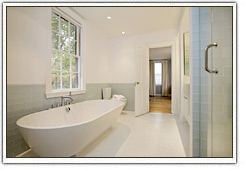 As readers of this newsletter know, we like to share the intriguing challenges and inspiring solutions that arise when renovating older homes. And as interesting as these functional fixes are, sometimes renovation is also about upgrading the look of a space. This recent project offers a little of both: As readers of this newsletter know, we like to share the intriguing challenges and inspiring solutions that arise when renovating older homes. And as interesting as these functional fixes are, sometimes renovation is also about upgrading the look of a space. This recent project offers a little of both:
When two university professors moved into a 1915 Colonial in Cambridge, they loved its many period charms with one exception: the master bath and dressing suite’s jarring 1970s design aesthetic. Seeking a clean and bright spa-like design, they asked us for help.
The process began by gutting the bathroom — which revealed an alarming situation: a previous renovation had eliminated all of the floor joists! With a deep and heavy soaking tub moving into the room, reframing of the entire floor became the first priority.
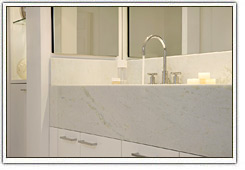 Next, the large tub was moved into the space while walls were opened, and repositioned around the room as the radiant heating system and new Ann Sacks tile were put in place. And because the tub would be located directly beneath the window, the original glass panes were replaced with tempered glass for safety. Next, the large tub was moved into the space while walls were opened, and repositioned around the room as the radiant heating system and new Ann Sacks tile were put in place. And because the tub would be located directly beneath the window, the original glass panes were replaced with tempered glass for safety.
Another issue – due to the location of an elevator directly behind the second-floor bath, electrical and plumbing systems needed to be run inside the shaft. And to achieve the clean look of a spa-style bath, the room’s lines had to be perfectly level — a real challenge in a 95-year-old house.
The comforting design, by Sandra Fairbank of Fairbank Design, Ltd., called for a lack of hard edges on the vanity. To accomplish this challenging feat of engineering, a countertop and apron were crafted as a single piece of Azul Cielo marble.
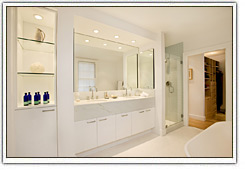 Handsome pullout cabinetry provides lots of room to place toiletries out of view, maintaining the uncluttered appeal. Pale blue tile by Ann Sachs lines the shower stall and surrounds the tub. And after enjoying a relaxing bath, the heated towel rack provides a warm finish. Handsome pullout cabinetry provides lots of room to place toiletries out of view, maintaining the uncluttered appeal. Pale blue tile by Ann Sachs lines the shower stall and surrounds the tub. And after enjoying a relaxing bath, the heated towel rack provides a warm finish.
We also remodeled the attached dressing area. By removing a sink from the space and adding square footage from the adjacent laundry room, equally spacious his-and-hers dressing areas were built, with shelving in warm maple and new oak flooring.
|
|
| |
 |
|
| |
EVENTS CALENDAR
 Now through June 3: History Drawn with Light: Early Photographs from the Collections of the Massachusetts Historical Society. View the works of professional and amateur 19th-century photographers, including one of Boston’s oldest photographs: “The Old Feather Store” by Francis Calley Gray. At the Massachusetts Historical Society, 1154 Boylston Street, Boston. Call 617/536-1608 for more information. Now through June 3: History Drawn with Light: Early Photographs from the Collections of the Massachusetts Historical Society. View the works of professional and amateur 19th-century photographers, including one of Boston’s oldest photographs: “The Old Feather Store” by Francis Calley Gray. At the Massachusetts Historical Society, 1154 Boylston Street, Boston. Call 617/536-1608 for more information.
Now through August 28: Embroideries of Colonial Boston at the Museum of Fine Arts, Boston. In eighteenth century Boston, handcrafted, embroidered pictures of nature, Biblical tableaus, and coats of arms were popular home décor. Fortunately, many were carefully preserved and passed down for generations. At the Museum of Fine Arts, 465 Huntington Avenue, Boston. Visit www.mfa.org for more information.
|
|
| |
 |
|
| |
 |
 |
 |
 |
 |
 |
|
|
NEWS |
|
|
 |
|
After serving for several years as the Facilities Chair at the Cambridge Historical Society, Charlie was recently elected as a vice president for the organization, which is located at Cambridge’s second-oldest house, the Hooper-Lee-Nichols house on Brattle Street. (The Cambridge Chronicle recently included Charlie’s article about the history and mysteries of the house). The CHS is dedicated to preserving the history and heritage of Cambridge, and in recent years has turned its attention toward chronicling the 20th century, adding collections from Rounder Records, the Harvard Square Business Association, the 1960s activist newspaper The Old Mole, and the efforts to introduce and maintain rent control in the city. If you’d like to hear more, get involved, or donate historically noteworthy items to the Society, please email executive director Gavin Kleespies at gwkleespies@cambridgehistory.org or call 617/547-4252.
In the Media:
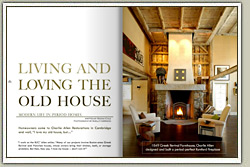 In the midst of a challenging winter, Charlie appeared on the Fox25 Morning News show to discuss removing ice dams and snow from your home’s roof. In the midst of a challenging winter, Charlie appeared on the Fox25 Morning News show to discuss removing ice dams and snow from your home’s roof.
In January, the Boston Globe featured a turret that we remodeled into an elegant dressing area/closet, along with tips from Charlie on other innovative renovation solutions.
Perspective Magazine offered a great feature on Charlie Allen Renovations, spotlighting some of our favorite projects. |
|
 |
 |
 |
 |
 |
 |
 |
|
|
| |
 |
|
| |
ASK MARK: After a dark, cold, and snowier-than-usual winter, finally sitting outside basking in warmth and sunlight is especially appealing. If your home currently lacks outdoor sitting space, it’s time to consider adding a deck. In this issue, CAR project development manager Mark Philben guides you through the process:
 STEP ONE: If you’re interested in building something that will seem original to your house, scout around your neighborhood for similar homes that already feature outdoor gathering space. And if you think that there might have been a deck on your house at one time, check with your community’s historic association: they may have photos or information that will guide you in finding the design that perfectly complements your home’s architecture. STEP ONE: If you’re interested in building something that will seem original to your house, scout around your neighborhood for similar homes that already feature outdoor gathering space. And if you think that there might have been a deck on your house at one time, check with your community’s historic association: they may have photos or information that will guide you in finding the design that perfectly complements your home’s architecture.
STEP TWO: Now that you’ve settled on the style you’re looking for, a professional remodeler can help you determine how to achieve that classic appearance while conforming to today’s building codes. For instance, rails are higher now than they used to be, and stairs need to be configured differently.
STEP THREE: Material selection. Pressure treated wood should be used only for the frame. Good decking choices include hardwoods like Meranti, Ipe, and Batu. Any of these, cut in a 1 x 4 size, will very closely mimic the 1x4 fir that was used traditionally. (Modern day fir does not hold up like the old growth fir used in the past, and we don’t recommend it.) Cedar decking is durable in New England weather, but it’s soft and dents/scratches very easily. If cedar appeals to you, use western red cedar for the rails and trim, which don’t get the kind of traffic wear that deck floorboards do.
STEP FOUR: Almost finished… Before putting it in place, make sure that all wood is pre-primed on all sides. (Decking should be pre-finished on the bottom side, too.) Decks on older homes were typically painted, so consider either a solid stain or house paint for handrails and trim. Decking can have a semi transparent or solid deck stain applied. If you’d like to finish some elements to highlight the wood grain, the decking would be the place to do that. A high quality hardwood oil finish with UV inhibitors will work fine.
STEP FIVE: Decking finishes need to be maintained. Your deck should be lightly sanded and finished with a new coat every 2-3 years even with a good quality finish. Handrails and trim can be done as often as the house is painted.
STEP SIX: Time to relax: get a comfortable deck chair, a good book, and a cold drink and prepare to bask in the summer sun. |
|
| |
 |
|
| |
|
|
| |
 |
|
| |
WHAT IS A PERIOD HOME? The Victorian Era
As far as we know, Queen Victoria, who reigned over the British Empire from 1837 to 1901, never sat down at a drafting table or picked up a hammer. Yet, in spite of this lack of design/build experience, Victoria’s name is synonymous with one of the most enduring and distinctive periods in residential design.
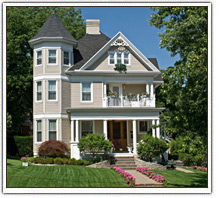 It’s worth noting that while houses are often called “Victorians,” the term does not actually refer to a specific style, but instead to the era in which a range of styles, including the Empire, Stick, Queen Anne, and Shingle became prominent. Each of these housing types offer a degree of architectural flash that was previously uncommon, including multi-colored walls in a variety of materials and textures, elaborate porch and eave adornments, towers, cupolas, turrets, balconies, bay windows, patterned roofs, wood shingles, and wraparound porches—sometimes all in one house. It’s worth noting that while houses are often called “Victorians,” the term does not actually refer to a specific style, but instead to the era in which a range of styles, including the Empire, Stick, Queen Anne, and Shingle became prominent. Each of these housing types offer a degree of architectural flash that was previously uncommon, including multi-colored walls in a variety of materials and textures, elaborate porch and eave adornments, towers, cupolas, turrets, balconies, bay windows, patterned roofs, wood shingles, and wraparound porches—sometimes all in one house.
Traditionally, there are two factors offered for the explosion in decorative housing styles during Victoria’s 64-year reign: first, the industrial revolution, which facilitated the design and construction of more elaborately conceived materials for a mass audience. In turn, these same advances in technology allowed for a growing middle class, now able to afford the sort of distinctive design that had long been possible only for the very rich. |
|
| |
 |
|
| |
 |
 |
 |
 |
 |
 |
|
|
OLD HOUSE READING |
|
|
 |
|
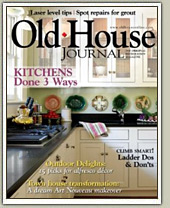 As you know, we love period architecture. We also love reading about it. Here are some of our favorite magazines — and one very interesting book: As you know, we love period architecture. We also love reading about it. Here are some of our favorite magazines — and one very interesting book:
This Old House focuses on do-it-yourself renovations, tools, and period-friendly materials.
Old House Journal offers specific solutions to older home issues and features outstanding period architecture from around the country.
Preservation is the award-winning magazine of the National Trust for Historic Preservation.
Locally, we’re blessed with several great publications that focus on the home, including Design New England, Boston Home, and New England Home. You might get more period style from New England Home, but both Boston Home and Design New England include older homes in the mix. And Design New England offers the “Icon” series, focusing on housing and landscape characteristic to the region. If you’re relaxing with your I-Pad, there are two new online publications that we enjoy: Perspective New England includes informative articles and a nice range of home profiles, while Surroundings is a great forum from blogger Linda Merrill for lovers of design and home goods.
Finally, book lovers should consider At Home: A Short History of Private Life, by Bill Bryson, which explores the genesis and history of nearly every area within the four walls and roof that we all call home. Publisher’s Weekly writes: “In demonstrating how everything we take for granted, from comfortable furniture to smoke-free air, went from unimaginable luxury to humdrum routine, Bryson shows us how odd and improbable our own lives really are.” |
|
 |
 |
 |
 |
 |
 |
 |
|
|
| |
 |
|
|
Charlie Allen Renovations | 91 River Street, Cambridge, MA 02139 |
|
|
|
|
|






 STEP ONE: If you’re interested in building something that will seem original to your house, scout around your neighborhood for similar homes that already feature outdoor gathering space. And if you think that there might have been a deck on your house at one time, check with your community’s historic association: they may have photos or information that will guide you in finding the design that perfectly complements your home’s architecture.
STEP ONE: If you’re interested in building something that will seem original to your house, scout around your neighborhood for similar homes that already feature outdoor gathering space. And if you think that there might have been a deck on your house at one time, check with your community’s historic association: they may have photos or information that will guide you in finding the design that perfectly complements your home’s architecture.  It’s worth noting that while houses are often called “Victorians,” the term does not actually refer to a specific style, but instead to the era in which a range of styles, including the Empire, Stick, Queen Anne, and Shingle became prominent. Each of these housing types offer a degree of architectural flash that was previously uncommon, including multi-colored walls in a variety of materials and textures, elaborate porch and eave adornments, towers, cupolas, turrets, balconies, bay windows, patterned roofs, wood shingles, and wraparound porches—sometimes all in one house.
It’s worth noting that while houses are often called “Victorians,” the term does not actually refer to a specific style, but instead to the era in which a range of styles, including the Empire, Stick, Queen Anne, and Shingle became prominent. Each of these housing types offer a degree of architectural flash that was previously uncommon, including multi-colored walls in a variety of materials and textures, elaborate porch and eave adornments, towers, cupolas, turrets, balconies, bay windows, patterned roofs, wood shingles, and wraparound porches—sometimes all in one house.  As you know, we love period architecture. We also love reading about it. Here are some of our favorite magazines — and one very interesting book:
As you know, we love period architecture. We also love reading about it. Here are some of our favorite magazines — and one very interesting book: